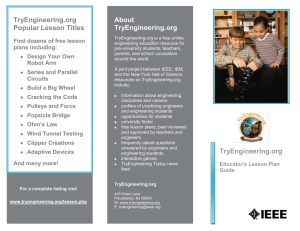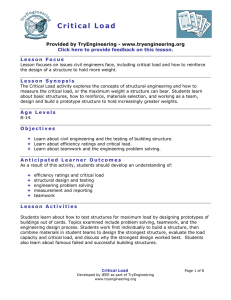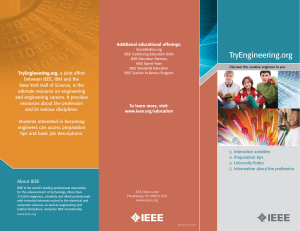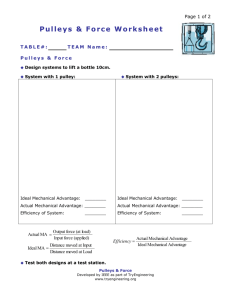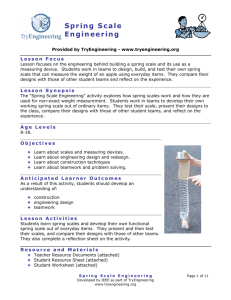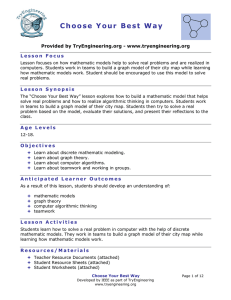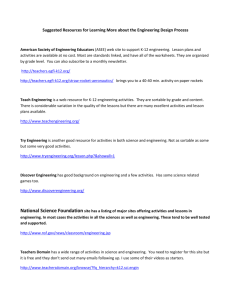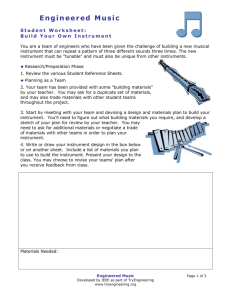Lesson Plan Template
advertisement
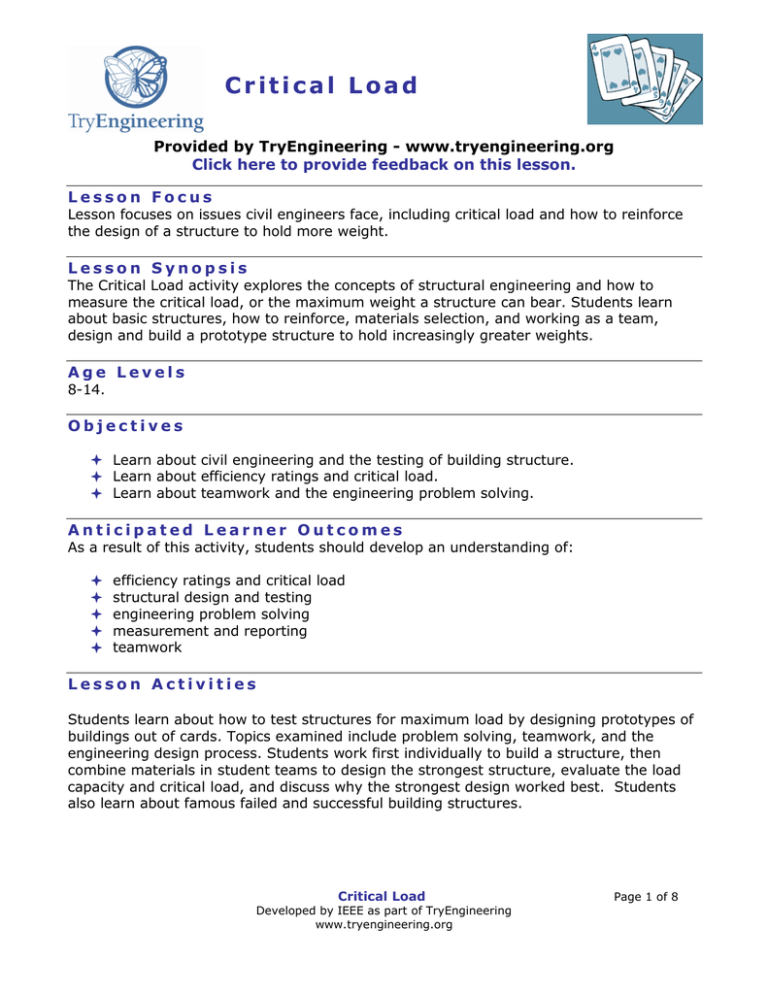
Critical Load Provided by TryEngineering - www.tryengineering.org Click here to provide feedback on this lesson. Lesson Focus Lesson focuses on issues civil engineers face, including critical load and how to reinforce the design of a structure to hold more weight. Lesson Synopsis The Critical Load activity explores the concepts of structural engineering and how to measure the critical load, or the maximum weight a structure can bear. Students learn about basic structures, how to reinforce, materials selection, and working as a team, design and build a prototype structure to hold increasingly greater weights. Age Levels 8-14. Objectives Learn about civil engineering and the testing of building structure. Learn about efficiency ratings and critical load. Learn about teamwork and the engineering problem solving. Anticipated Learner Outcomes As a result of this activity, students should develop an understanding of: efficiency ratings and critical load structural design and testing engineering problem solving measurement and reporting teamwork Lesson Activities Students learn about how to test structures for maximum load by designing prototypes of buildings out of cards. Topics examined include problem solving, teamwork, and the engineering design process. Students work first individually to build a structure, then combine materials in student teams to design the strongest structure, evaluate the load capacity and critical load, and discuss why the strongest design worked best. Students also learn about famous failed and successful building structures. Critical Load Developed by IEEE as part of TryEngineering www.tryengineering.org Page 1 of 8 Resources/Materials Teacher Resource Documents (attached) Student Resource Sheet (attached) Student Worksheet (attached) Alignment to Curriculum Frameworks See attached curriculum alignment sheet. Internet Connections TryEngineering (www.tryengineering.org) Bryan Burg Cardstacker (www.cardstacker.com/index2.html) Great Structures of the World (http://greatstructures.info) ITEA Standards for Technological Literacy: Content for the Study of Technology (www.iteaconnect.org/TAA) National Science Education Standards (www.nsta.org/publications/nses.aspx) Recommended Reading Stacking the Deck : Secrets of the World's Master Card Architect by Bryan Berg (ISBN: 0743232879) Why Buildings Stand Up: The Strength of Architecture by Mario Salvadori (ISBN: 0393306763) Why Buildings Fall Down: How Structures Fail Architecture by Mario Salvadori (ISBN: 039331152X) Optional Writing Activities Write an essay or a paragraph describing a recognizable building in your town. Include the history, interesting challenges to the building's engineering, and challenges that the engineers faced in design and construction. Critical Load Developed by IEEE as part of TryEngineering www.tryengineering.org Page 2 of 8 Critical Load For Teachers: Teacher Resources Lesson Goal Explores the concepts of structural engineering and how to measure the critical load, or the weight at which a structure will fail. Students learn about basic structures, how to reinforce, materials selection, and working as a team, design and build a prototype structure to hold the greatest weight. Lesson Objectives Students learn about civil engineering and the testing of building structures. Students learn about critical load. Students learn about teamwork and engineering problem solving. Materials • Student Resource Sheets • Student Worksheets • One set of materials for each student team: o twelve unused playing cards o one roll of scotch tape o 4 coins • Testing materials: o Base of empty square based two quart cardboard juice/milk container o Objects to build weight of base from 4 - 10 pounds (coins, marbles, sand) Procedure 1. Show students the student reference sheet. These may be read in class or provided as reading material for the prior night's homework. 2. Provide each student team with materials and ask them to devise a structure that will hold the most weight. They are to plan out their structure, and build a prototype for testing. Allow 10 minutes for planning and execution. 3. Instructor places weights on each team's prototype increasing the weight until the structure fails. Students chart the maximum load each prototype successfully held (the amount just prior to failure) 4. Each student group presents their vision for their design, and explains why they think their design did well or failed. Ask students how would they adjust the design if they could do it again? Time Needed One to two 45 minute sessions. Critical Load Developed by IEEE as part of TryEngineering www.tryengineering.org Page 3 of 8 Critical Load Student Resource: Civil Engineering Challenges What Civil Engineers Do Civil engineers are problem solvers, meeting the challenges of pollution, traffic congestion, drinking water and energy needs, urban redevelopment, and community planning. This activity focuses on the work of structural engineers who face the challenge of designing structures that support their own weight and the loads they carry, and that resist wind, temperature, earthquake, and many other forces. Famous Building Failures The John Hancock Tower in Boston, Massachusetts is said to have been "known more for its early engineering flaws than for its architectural achievement." Wind-induced swaying was so large, it was said to cause motion sickness for people on the upper-floors. This problem was solved by adding a pair of 300-ton dampers on the 58th floor. Another unrelated but serious problem was that 65 of its 10,344 floor-to-ceiling plate-glass windowpanes fell out of the building to the ground during construction -- luckily no injuries resulted to either workers or passersby! Another example is a library built at Syracuse University in the late 1970's was built without having taken into consideration the weight of the books! Famous Structures • The Stratosphere Tower in Las Vegas, Nevada, is the tallest free-standing tower (1,149 feet) in the United States, rising taller than Paris' Eiffel Tower, and the Tokyo Tower. • The world's tallest bridge is in France and spans the Tarn valley. It is 2460m long and is supported by seven piers ranging from 77m to 244m in height. • The Petronas Twin Towers in Kuala Lumpur, Malaysia, are the tallest office buildings in the world. They soar 451.9 metres from street level. • The CN Tower in Toronto, Ontario, Canada has the title of "World's Tallest Building and Free-Standing Structure." It is 1,815' 5" or 553.33m tall. • Canada also has the world's largest shopping and entertainment complex -- the West Edmonton Mall in Edmonton, Alberta. It spans 49 hectares (121 acres) an houses over 800 stores! Efficiency Ratings and Critical Load The efficiency rating measures the weight that will cause a structure to fail divided by the weight of the structure itself. The most efficient structures are strong and lightweight - a difficult combination to achieve. For example, roofers in areas which experience heavy snows must factor in the weight of a massive snowstorm into designing the strength of the roof. The weight at which a building or structure fails is called the "critical load." Critical Load Developed by IEEE as part of TryEngineering www.tryengineering.org Page 4 of 8 Critical Load Student Worksheet: Measuring Critical Load - Page One Step One: You have been provided with four playing cards, some scotch tape, and scissors. As a team, and without altering (cutting for example) the cards, devise a structure that you think will hold up a two quart/64 oz/1.69L container without collapsing. Question: 1. What is your team's strategy or plan for construction? Prediction: 1. Predict the "critical load" of your structure as you have designed it. Step Two: As a team, build your structure (prototype) for testing. Step Three: Your instructor will test your structure, and determine at what weight your team's structure will fail by adding measurable weights (coins, sand, other materials) until it collapses. This is your structure's "critical load." Questions: 1. What was your structure's "critical load?" 2. How close were you to your prediction from Step One? Critical Load Developed by IEEE as part of TryEngineering www.tryengineering.org Page 5 of 8 Critical Load Student Worksheet: Measuring Critical Load - Page Two 3. What aspects of your design do you think helped its ability to hold more weight? 4. What aspects of your design do you think hindered its ability to hold more weight? 5. What was the highest critical load in your classroom? 6. What was the difference in the winner's design and yours? Or…if your team had the winning structure, what do you think set your structure apart from the rest? 7. If you could do your design all over….what would you change, and why? 8. What human factors do you think a civil/structural engineer needs to take into consideration when planning an office building? (examples are the weight of people and furnishings, need for water, fresh air, escape routes) Critical Load Developed by IEEE as part of TryEngineering www.tryengineering.org Page 6 of 8 Critical Load For Teachers: Alignment to Curriculum Frameworks Note: Lesson plans in this series are aligned to one or more of the following sets of standards: • U.S. Science Education Standards (http://www.nap.edu/catalog.php?record_id=4962) • U.S. Next Generation Science Standards (http://www.nextgenscience.org/) • International Technology Education Association's Standards for Technological Literacy (http://www.iteea.org/TAA/PDFs/xstnd.pdf) • U.S. National Council of Teachers of Mathematics' Principles and Standards for School Mathematics (http://www.nctm.org/standards/content.aspx?id=16909) • U.S. Common Core State Standards for Mathematics (http://www.corestandards.org/Math) • Computer Science Teachers Association K-12 Computer Science Standards (http://csta.acm.org/Curriculum/sub/K12Standards.html) National Science Education Standards Grades K-4 (ages 4-9) CONTENT STANDARD B: Physical Science As a result of the activities, all students should develop an understanding of Properties of objects and materials CONTENT STANDARD F: Science in Personal and Social Perspectives As a result of activities, all students should develop understanding of Risks and benefits Science and technology in society CONTENT STANDARD G: History and Nature of Science As a result of activities, all students should develop understanding of History of science National Science Education Standards Grades 5-8 (ages 10-14) CONTENT STANDARD E: Science and Technology As a result of activities in grades 5-8, all students should develop Abilities of technological design Understandings about science and technology CONTENT STANDARD F: Science in Personal and Social Perspectives As a result of activities, all students should develop understanding of Risks and benefits Science and technology in society CONTENT STANDARD G: History and Nature of Science As a result of activities, all students should develop understanding of Nature of science History of science Next Generation Science Standards Grades 3-5 (Ages 8-11) Motion and Stability: Forces and Interactions Students who demonstrate understanding can: 3-PS2-1. Plan and conduct an investigation to provide evidence of the effects of balanced and unbalanced forces on the motion of an object. Engineering Design Students who demonstrate understanding can: 3-5-ETS1-1.Define a simple design problem reflecting a need or a want that includes specified criteria for success and constraints on materials, time, or cost. Critical Load Developed by IEEE as part of TryEngineering www.tryengineering.org Page 7 of 8 Critical Load For Teachers: Alignment to Curriculum Frameworks Next Generation Science Standards Grades 3-5 (Ages 8-11) Engineering Design 3-5-ETS1-2.Generate and compare multiple possible solutions to a problem based on how well each is likely to meet the criteria and constraints of the problem. 3-5-ETS1-3.Plan and carry out fair tests in which variables are controlled and failure points are considered to identify aspects of a model or prototype that can be improved. Next Generation Science Standards Grades 6-8 (Ages 11-14) Engineering Design MS-ETS1-2 Evaluate competing design solutions using a systematic process to determine how well they meet the criteria and constraints of the problem. Standards for Technological Literacy - All Ages The Nature of Technology Standard 1: Students will develop an understanding of the characteristics and scope of technology. Standard 3: Students will develop an understanding of the relationships among technologies and the connections between technology and other fields of study. Technology and Society Standard 4: Students will develop an understanding of the cultural, social, economic, and political effects of technology. Standard 6: Students will develop an understanding of the role of society in the development and use of technology. Standard 7: Students will develop an understanding of the influence of technology on history. Design Standard 9: Students will develop an understanding of engineering design. Standard 10: Students will develop an understanding of the role of troubleshooting, research and development, invention and innovation, and experimentation in problem solving. Abilities for a Technological World Standard 11: Students will develop abilities to apply the design process. Standard 13: Students will develop abilities to assess the impact of products and systems. The Designed World Standard 20: Students will develop an understanding of and be able to select and use construction technologies. Critical Load Developed by IEEE as part of TryEngineering www.tryengineering.org Page 8 of 8

